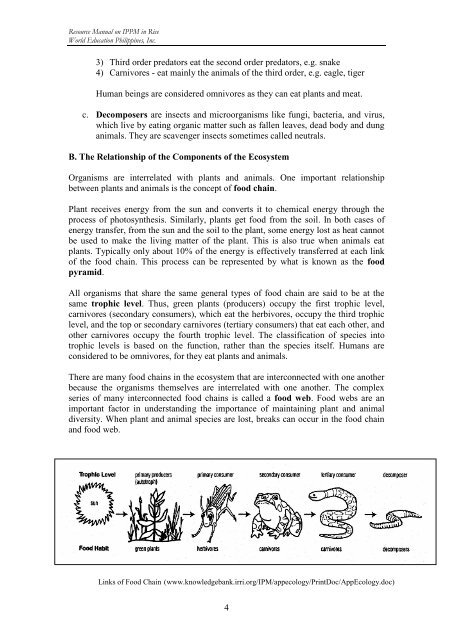Resource Manual on Integrated Production and Pest ... - julitoaligaen
Resource Manual on Integrated Production and Pest ... - julitoaligaen
Resource Manual on Integrated Production and Pest ... - julitoaligaen
Create successful ePaper yourself
Turn your PDF publications into a flip-book with our unique Google optimized e-Paper software.
<str<strong>on</strong>g>Resource</str<strong>on</strong>g> <str<strong>on</strong>g>Manual</str<strong>on</strong>g> <strong>on</strong> IPPM in Rice<br />
World Educati<strong>on</strong> Philippines, Inc.<br />
3) Third order predators eat the sec<strong>on</strong>d order predators, e.g. snake<br />
4) Carnivores - eat mainly the animals of the third order, e.g. eagle, tiger<br />
Human beings are c<strong>on</strong>sidered omnivores as they can eat plants <strong>and</strong> meat.<br />
c. Decomposers are insects <strong>and</strong> microorganisms like fungi, bacteria, <strong>and</strong> virus,<br />
which live by eating organic matter such as fallen leaves, dead body <strong>and</strong> dung<br />
animals. They are scavenger insects sometimes called neutrals.<br />
B. The Relati<strong>on</strong>ship of the Comp<strong>on</strong>ents of the Ecosystem<br />
Organisms are interrelated with plants <strong>and</strong> animals. One important relati<strong>on</strong>ship<br />
between plants <strong>and</strong> animals is the c<strong>on</strong>cept of food chain.<br />
Plant receives energy from the sun <strong>and</strong> c<strong>on</strong>verts it to chemical energy through the<br />
process of photosynthesis. Similarly, plants get food from the soil. In both cases of<br />
energy transfer, from the sun <strong>and</strong> the soil to the plant, some energy lost as heat cannot<br />
be used to make the living matter of the plant. This is also true when animals eat<br />
plants. Typically <strong>on</strong>ly about 10% of the energy is effectively transferred at each link<br />
of the food chain. This process can be represented by what is known as the food<br />
pyramid.<br />
All organisms that share the same general types of food chain are said to be at the<br />
same trophic level. Thus, green plants (producers) occupy the first trophic level,<br />
carnivores (sec<strong>on</strong>dary c<strong>on</strong>sumers), which eat the herbivores, occupy the third trophic<br />
level, <strong>and</strong> the top or sec<strong>on</strong>dary carnivores (tertiary c<strong>on</strong>sumers) that eat each other, <strong>and</strong><br />
other carnivores occupy the fourth trophic level. The classificati<strong>on</strong> of species into<br />
trophic levels is based <strong>on</strong> the functi<strong>on</strong>, rather than the species itself. Humans are<br />
c<strong>on</strong>sidered to be omnivores, for they eat plants <strong>and</strong> animals.<br />
There are many food chains in the ecosystem that are interc<strong>on</strong>nected with <strong>on</strong>e another<br />
because the organisms themselves are interrelated with <strong>on</strong>e another. The complex<br />
series of many interc<strong>on</strong>nected food chains is called a food web. Food webs are an<br />
important factor in underst<strong>and</strong>ing the importance of maintaining plant <strong>and</strong> animal<br />
diversity. When plant <strong>and</strong> animal species are lost, breaks can occur in the food chain<br />
<strong>and</strong> food web.<br />
Links of Food Chain (www.knowledgebank.irri.org/IPM/appecology/PrintDoc/AppEcology.doc)<br />
4


